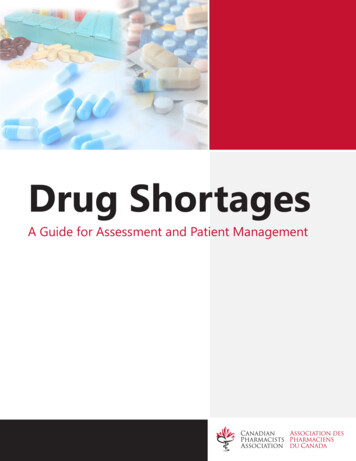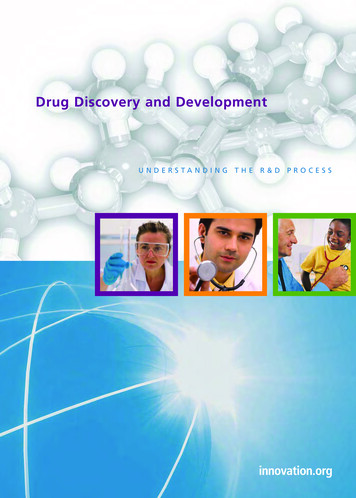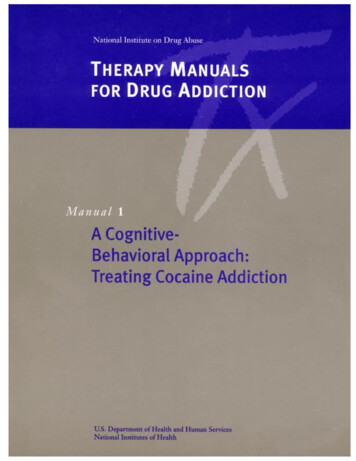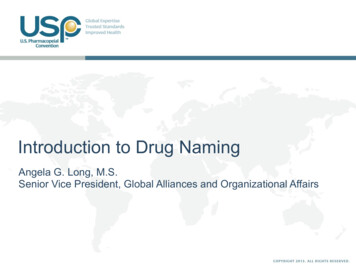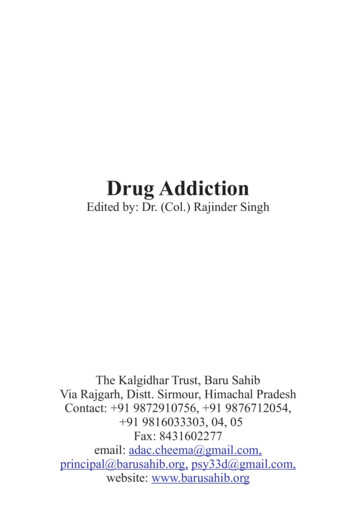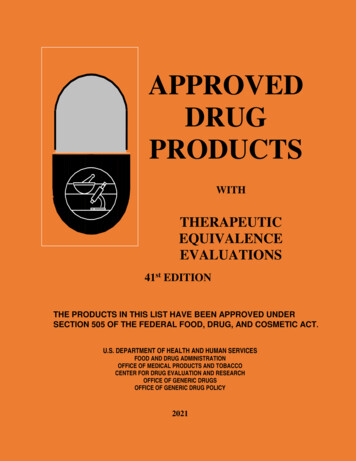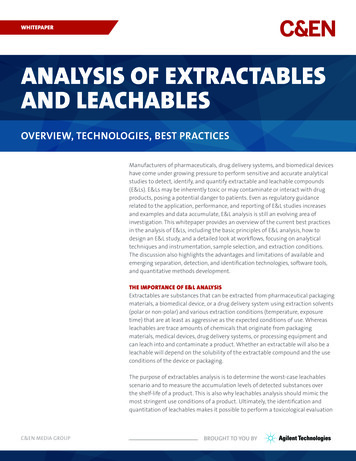
Transcription
Vol. 1 No. 4 2012Online Available at www.thepharmajournal.comTHE PHARMA INNOVATIONTransdermal Drug Delivery System: A ReviewDipen Patel*1, Sunita A. Chaudhary1, Bhavesh Parmar1, Nikunj Bhura11. Arihant School of Pharmacy and Bio-Research Institute, Gandhinagar, Gujrat, IndiaA transdermal patch is a medicated adhesive patch that is placed on the skin to deliver a specificdose of medication through the skin and into the bloodstream. Often, this promotes healing to aninjured area of the body. An advantage of a transdermal drug delivery route over other types ofmedication delivery such as oral, topical, intravenous, intramuscular, etc. is that the patchprovides a controlled release of the medication into the patient, usually through either a porousmembrane covering a reservoir of medication or through body heat melting thin layers ofmedication embedded in the adhesive. The main disadvantage to transdermal delivery systemsstems from the fact that the skin is a very effective barrier; as a result, only medications whosemolecules are small enough to penetrate the skin can be delivered in this method. A wide varietyof pharmaceuticals are now available in transdermal patch form.Keyword: transdermal drug delivery system, bioavability, Iontophoresis, Electroporation,ultrasound, microscopic projectionINTRODUCTION: Transdermal patch (Skinpatch) uses a special membrane to control the rateat which the liquid drug contained in the reservoirwithin the patch can pass through the skin andinto the bloodstream. Some drugs must becombined with substances, such as alcohol, thatincrease their ability to penetrate the skin in orderto be used in a skin patch. Drugs administeredthrough skin patches include scopolamine (formotion sickness), nicotine (for quitting smoking),estrogen (for menopause and to preventosteoporosis after menopause), nitroglycerin (forangina), and lidocaine to relieve the pain ofshingles (herpes zoster). Molecules of insulin andCorresponding Author’s Contact information:Dipen Patel *Arihant School of Pharmacy and Bio-Research Institute,Gandhinagar, Gujrat, IndiaE-mail: zalak.225@gmail.comVol. 1 No. 4 2012many other substances, however, are too largeto pass through the skin.Patches applied to the skin eliminate the needfor vascular access by syringe or the use ofpumps. Transdermal patches were developed inthe 1970s and the first was approved by theFDA in 1979 for the treatment of motionsickness. It was a three-day patch that deliveredscopolamine. In 1981, patches for nitroglycerinwere approved, and today there exist a numberof patches for drugs such as clonidine, fentanyl,lidocaine, nicotine, nitroglycerin, oestradiol,oxybutinin, scopolamine, and testosterone.There are also combination patches forcontraception, as well as hormone replacement.Depending on the drug, the patches generallylast from one to seven days.www.thepharmajournal.comPage 66
Dipen Patel*, Sunita A. Chaudhary, Bhavesh Parmar, Nikunj BhuraThe major advantages provided by transdermaldrug delivery include the following: improvedbioavailability, more uniform plasma levels,longer duration of action resulting in a reductionin dosing frequency, reduced side effects andimproved therapy due to maintenance of plasmalevels up to the end of the dosing intervalcompared to a decline in plasma levels withconventional oral dosage forms. Transdermalpatches have been useful in developing newapplications for existing therapeutics and forreducing first-pass drug-degradation effects.Patches can also reduce side effects; forexample, oestradiol patches are used by morethan a million patients annually and, in contrastto oral formulations, do not cause liver damage.of two major sub-categories - therapeutic andcosmetic), aroma patches, weight loss patches,and Non-medicated patch markets includethermal and cold patches, nutrient patches, skincare patches (a category that consists patchesthat measure sunlight exposure.DefinitionA transdermal patch or skin patch is a medicatedadhesive patch that is placed on the skin todeliver a specific dose of medication through theskin and into the bloodstream.to manage or dangerous needles to dispose of,and there are few or no gastrointestinal effectsfrom the drug itself. Peak plasma levels of thedrug are reduced, leading to decreased sideeffects. In addition, transdermal delivery is usefulfor those drugs that have a high first pass effectthrough the liver, have poor oral uptake, needfrequent administration, or that interact withstomach acid. The first pass effect results in thedestruction of a significant amount of the drug.Drugs absorbed through the skin, however, enterthe general circulation directly avoiding the liver,with less total drug absorption occurring Topical patches are a painless, noninvasive way to deliver substancesdirectly into the body. Topical patches are a better way to deliversubstances that are brokendown by thestomach acids, not well-absorbed from thegut, orextensively degraded by the liver. Topical patches over a controlled, steadydelivery of medication over longperiodsof time. Topical patches have fewer side effectsthan oral medications orsupplements. Topical patches are easier to use andremember. Topical patches over an alternative topeople who cannot, or prefer not to takemedications or supplements orally. Topical patches are cost-effective. People prefer topical patches.Limitation TDDS cannot deliver ionic drugs. TDDS cannot achieve high drug levels inblood/plasma. It cannot develop for drugs of largemolecular size.Advantages of transdermal patchesThe advantages of transdermal delivery areobvious even delivery of a therapeutic level ofdrug is painless, the patient does not need toinject himself, there are no bulky delivery devicesVol. 1 No. 4 2012 TDDS cannot deliver drugs in a pulsatilefashion. TDDS cannot develop if drugformulation causes irritation to skin.www.thepharmajournal.comorPage 67
Dipen Patel*, Sunita A. Chaudhary, Bhavesh Parmar, Nikunj BhuraLimitation of TDDS can be overcome to someextent by novel approaches such as Iontophoresis,electroporation and ultrasound.Popular uses The highest selling transdermal patch inthe United States is the nicotine patch,which releases nicotine in controlleddoses to help with cessation of tobaccosmoking. The first commercially availablevapour patch to reduce smoking wasapproved in Europe in 2007. Two opioid medications used to provideround-the-clock relief for severe pain areoften prescribed in patch form: Fentanyl(marketedasDuragesic)andBuprenorphine (marketed as BuTrans). Estrogenpatchesaresometimesprescribed to treat menopausal symptomsas well as post-menopausal osteoporosis.Other transdermal patches for hormonedelivery include the contraceptive patch(marketed as Ortho Evra or Evra). Nitroglycerin patches are sometimesprescribed for the treatment of angina inlieu of sublingual pills. The anti-hypertensive drug Clonidine isavailable in transdermal patch form underthe brand name Catapres-TTS. Emsam, a transdermal form of the MAOIselegiline, became the first transdermaldelivery agent for an antidepressantapproved for use in the U.S. in March2006.manufacturers of the Fentanyl patch, AlzaPharmaceuticals (a division of major medicalmanufacturer Johnson & Johnson) and Sandoz,subsequently issued a recall of their versions ofthe patch due to a manufacturing defect thatallowed the gel containing the medication to leakout of its pouch too quickly, which could result inoverdose and death. As of 2010, Sandoz nolonger uses gel in its transdermal fentanyl patch;instead, Sandoz-branded fentanyl patches use amatrix/adhesivesuspension(wherethemedication is blended with the adhesive insteadof held in a separate pouch with a porousmembrane), similar to other fentanyl patchmanufacturers such as Mylan and Janssen.In 2007, Shire and Noven Pharmaceuticals,manufacturers of the Daytrana ADHD patch,announced a voluntary recall of several lots of thepatch due to problems with separating the patchfrom its protective release liner. Since then, nofurther problems with either the patch or itsprotective packaging have been reported.In 2009, the FDA announced a public healthadvisory warning of the risk of burns during MRIscans from transdermal drug patches withmetallic backings. Patients should be advised toremove any medicated patch prior to an MRI scanand replace it with a new patch after the scan iscomplete.Skin burns have occurred with metal containingtransdermal patches at the time of shock therapyfrom external as well as internal cardioverterdefibrillators (ICD).Adverse eventsIn 2005, the FDA announced that they wereinvestigating reports of death and other seriousadverse events related to narcotic overdose inpatients using Duragesic, the fentanyl transdermalpatch for pain control. The Duragesic productlabel was subsequently updated to add safetyinformation in June 2005. In 2008, twoVol. 1 No. 4 2012The main components to a transdermal patch areLiner - Protects the patch during storage. Theliner is removed prior to use. Drug - Drugsolution in direct contact with release liner.Adhesive - Serves to adhere the components ofthe patch together along with adhering the patchwww.thepharmajournal.comPage 68
Dipen Patel*, Sunita A. Chaudhary, Bhavesh Parmar, Nikunj Bhurato the skin. Membrane - Controls the release ofthe drug from the reservoir and multi-layerpatches. Backing - Protects the patch from theouter environmentFormulation factors include(1)Physical chemistry of transport (2) Vehiclesand membrane used (3) Penetration enhancersused (4) Method of application (5) Device usedConditions in which Transdermal patches areusedCare taken while applying transdermal patchTransdermal patch is used when:(1)When the patient has intolerable sideeffects (including constipation) and who isunable to take oral medication (dysphagia)and is requesting an alternative method ofdrug delivery.(2) Where the pain control might be improvedby reliable administration. This might beuseful in patients with cognitive impairmentor those who for other reasons are not able toself-medicate with their analgesia.(3) It can be used in combination with otherenhancement strategies to produce synergisticeffects.Conditions in which Transdermal patches are notusedThe use of transdermal patch is not suitablewhen:(1)The part of the skin where the patch is to beapplied should be properly cleaned. (2) Patchshould not be cut because cutting the patchdestroys the drug delivery system. (3) Beforeapplying a new patch it should be made sure thatthe old patch is removed from the site. (4) Careshould be taken while applying or removing thepatch because anyone handling the patch canabsorb the drug from the patch. (5) The patchshould be applied accurately to the site ofadministration.Mechanism of Action of Transdermal PatchThe application of the transdermal patch and theflow of the active drug constituent from the patchto the circulatory system via skin occur throughvarious methods.(1)Cure for acute pain is required.(2) Where rapid dose titration is required.(3) Where requirement of dose is equal to orless than 30 mg/24 hrs.Factors affecting transdermal bioavaibilityTwo major factors affect the bioavaibility of thedrug via transdermal routes:(1)Physiological factors (2) Formulation factorsPhysiological factors include(1)Stratum corneum layer of the skin (2)Anatomic site of application on the body (3) Skincondition and disease (4) Age of the patient (5)Skin metabolism (6) Desquamation (peeling orflaking of the surface of the skin) (7) Skinirritation and sensitization (7) RaceVol. 1 No. 4 20121. IontophoresisIontophoresis passes a few milliamperes ofcurrent to a few square centimeters of skinthrough the electrode placed in contact with theformulation, which facilitates drug deliveryacross the barrier. Mainly used of pilocarpinedelivery to induce sweating as part of cysticfibrosis diagnostic test. Iontophoretic delivery oflidocaine appears to be a promising approach forrapid onset of anesthesia.www.thepharmajournal.comPage 69
Dipen Patel*, Sunita A. Chaudhary, Bhavesh Parmar, Nikunj Bhura2. ElectroporationElectroporation is a method of application ofshort, high-voltage electrical pulses to the skin.After electroporation, the permeability of the skinfor diffusion of drugs is increased by 4 orders ofmagnitude. The electrical pulses are believed toform transient aqueous pores in the stratumcorneum, through which drug transport occurs. Itis safe and the electrical pulses can beadministered painlessly using closely spacedelectrodes to constrain the electric field within thenerve-free stratum corneum.together, along with the entire system to the skin,but is also responsible for the releasing of thedrug. The adhesive layer is surrounded by atemporary liner and a backing.3. Application by ultrasoundApplication of ultrasound, particularly lowfrequency ultrasound, has been shown to enhancetransdermal transport of various drugs includingmacromolecules. It is also known assonophoresis. Katz et al. reported on the use oflow-frequency sonophoresis for topical deliveryof EMLA cream.4. Use of microscopic ions called microneedles were used tofacilitate transdermal drug transport. Needlesranging from approximately 10-100 µm in lengthare arranged in arrays. When pressed into theskin, the arrays make microscopic punctures thatare large enough to deliver macromolecules, butsmall enough that the patient does not feel thepenetration or pain. The drug is surface coated onthe microneedles to aid in rapid absorption. Theyare used in development of cutaneous vaccinesfor tetanus and influenza.Various other methods are also used for theapplication of the transdermal patches ical waves. However, these methodsare in their early stage of development andrequired further detail studying.Types of Transdermal Patch1. Single-layer Drug-in-AdhesiveThe adhesive layer of this system also containsthe drug. In this type of patch the adhesive layernot only serves to adhere the various layersVol. 1 No. 4 20122. Multi-layer Drug-in-AdhesiveThe multi-layer drug-in adhesive patch is similarto the single-layer system in that both adhesivelayers are also responsible for the releasing of thedrug. The multi-layer system is different howeverthat it adds another layer of drug-in-adhesive,usually separated by a membrane (but not in allcases). This patch also has a temporary liner-layerand a permanent backing.3. ReservoirUnlike the Single-layer and Multi-layer Drug-inadhesive systems the reservoir transdermalsystem has a separate drug layer. The drug layeris a liquid compartment containing a drugsolution or suspension separated by the adhesivelayer. This patch is also backed by the backingwww.thepharmajournal.comPage 70
Dipen Patel*, Sunita A. Chaudhary, Bhavesh Parmar, Nikunj Bhuralayer. In this type of system the rate of release iszero order.Drugs used in the Transdermal PatchBrand DrugNameManufacturerIndicationsNicotin nMatrife Fentanyl NycomednRPain reliefpatchOrtho Norelgostr ORTHO-McNEIL PostmenstrEvraTM omin/ualsyndromeEthinylEstradiol4. MatrixThe Matrix system has a drug layer of a semisolidmatrix containing a drug solution or suspension.The adhesive layer in this patch surrounds thedrug layer partially overlaying it.NuPatc Diclofenac Zydus Cadilah 100 diethylamineNeupro RigotineRAntiInflammatoryUCB and Schwarz early-stagePharmaidiopathicParkinson’s diseaseAlora Estradiol TheraTech/Proctol Postmenstrand GambleualsyndromeNicode NicotinermR5. Vapour PatchIn this type of patch the adhesive layer not onlyserves to adhere the various layers together butalso to release vapour. The vapour patches arenew on the market and they release essential oilsfor up to 6 hours. The vapours patches releaseessential oils and are used in cases ofdecongestion mainly. Other vapour patches onthe market are controller vapour patches thatimprove the quality of sleep. Vapour patches thatreduce the quantity of cigarettes that one smokesin a month are also available on the market.Alza/GlaxoSmithK SmokinglinecessationEstrade Estradiol Alza/NorvatisrmPostmenstrualsyndromeClimar Estradiol 3MPostmenstraPharmaceuticals/B ualerlexsyndromeLabsAndrod Testostero TheraTech/GlaxoS HypogonaermnemithKlinedism inmalesVol. 1 No. 4 2012www.thepharmajournal.comPage 71
Dipen Patel*, Sunita A. Chaudhary, Bhavesh Parmar, Nikunj BhuraNitrodi Nitroglyce RobertsscrinPharmaceuticalsAnginapectorisTransd Scopolami Alza/Norvatiserm- neScopRMotionsicknessNuvell Estrogen/P EthicalHormonee TS rogeHoldings/Schering replacemesteronent therapyDeponi Nitroglyce Schwarz-PharmatrinAnginapectorisNitro- Nitroglyce KeydurrinPharmaceuticalsAnginapectorisCatapre Clonidine Alza/Boehingers TTSRIngelheimHypertensionFemPat Estradiol Parke-DavischPostmenstrualsyndromeMinitra Nitroglyce 3MnrinPharmaceuticalsAnginapectorisClimad Estradiol EthicalPostmenstrermHoldings/Wyeth- ualAyerestsyndromeDurage Fentanyl strade Estradiol Alza/NorvatisrmPostmenstrualsyndromeTransd Nitroglyce Alza/Norvatiserm- rinNitroRAnginapectorisTestod Testostero AlzaermneTTSRHypogonadism inVol. 1 No. 4 2012malesOxytrol oxybutyni Watson PharmaRnProstep NicotineOveractivebladderElan Corp./Lederle SmokingLabscessationEvaluation of Transdermal Patches Physicochemical evaluation In vitro evaluation In vivo evaluation1. Physicochemical Evaluation:Thickness: The thickness of transdermal film isdetermined by travelling microscope, dial gauge,screw gauge or micrometer at different points ofthe film.Uniformity of weight: Weight variation isstudied by individually weighing 10 randomlyselected patches and calculating the averageweight. The individual weight should not deviatesignificantly from the average weight.Drug content determination: An accuratelyweighed portion of film (about 100 mg) isdissolved in 100 mL of suitable solvent in whichdrug is soluble and then the solution is shakencontinuously for 24 h in shaker incubator. Thenthe whole solution is sonicated. After sonicationand subsequent filtration, drug in solution isestimated spectrophotometrically by appropriatedilution.Content uniformity test: 10 patches are selectedand content is determined for individual patches.If 9 out of 10 patches have content between 85%to 115% of the specified value and one hascontent not less than 75% to 125% of thespecified value, then transdermal patches pass thetest of content uniformity. But if 3 patches havecontent in the range of 75% to 125%, thenadditional 20 patches are tested for drug content.If these 20 patches have range from 85% to115%, then the transdermal patches pass the test.Moisture content: The prepared films areweighed individually and kept in a desiccatorswww.thepharmajournal.comPage 72
Dipen Patel*, Sunita A. Chaudhary, Bhavesh Parmar, Nikunj Bhuracontaining calcium chloride at room temperaturefor 24 h. The films are weighed again after aspecified interval until they show a constantweight. The percent moisture content iscalculated using following formula.the elongation of the film. The weight justsufficient to break the film is noted. The tensilestrength can be calculated using the followingequation.% Moisture content Initial weight – Finalweight X 100F is the force required to break; a is width of film;b is thickness of film; L is length of film; l iselongation of film at break point.Moisture Uptake: Weighed films are kept in adesiccator at room temperature for 24 h. Theseare then taken out and exposed to 84% relativehumidity using saturated solution of Potassiumchloride in a desiccator until a constant weight isachieved. % moisture uptake is calculated asgiven below.% moisture uptake Final weight – Initial weightX 100Flatness: A transdermal patch should possess asmooth surface and should not constrict withtime. This can be demonstrated with flatnessstudy. For flatness determination, one strip is cutfrom the centre and two from each side ofpatches. The length of each strip is measured andvariation in length is measured by determiningpercent constriction. Zero percent constriction isequivalent to 100 percent flatness.Tensile strength F/a.b (1 L/l)Tack properties: It is the ability of the polymerto adhere to substrate with little contact pressure.Tack is dependent on molecular weight andcomposition of polymer as well as on the use oftackifying resins in polymer.Thumb tack test: The force required to removethumb from adhesive is a measure of tack.Rolling ball test: This test involves measurementof the distance that stainless steel ball travelsalong an upward facing adhesive. The less tackythe adhesive, the further the ball will travel.Quick stick (Peel tack) test: The peel forcerequired breaking the bond between an adhesiveand substrate is measured by pulling the tapeaway from the substrate at 90? at the speed of 12inch/min.Probe tack test: Force required to pull a probeaway from an adhesive at a fixed rate is recordedas tack.% constriction I1 – I2 X 100I2 Final length of each stripI1 Initial length of each stripFolding Endurance: Evaluation of foldingendurance involves determining the foldingcapacity of the films subjected to frequentextreme conditions of folding. Folding enduranceis determined by repeatedly folding the film at thesame place until it break. The number of timesthe films could be folded at the same placewithout breaking is folding endurance value.Tensile Strength: To determine tensile strength,polymeric films are sandwiched separately bycorked linear iron plates. One end of the films iskept fixed with the help of an iron screen andother end is connected to a freely movable threadover a pulley. The weights are added gradually tothe pan attached with the hanging end of thethread. A pointer on the thread is used to measureVol. 1 No. 4 20122. In vitro release studies:The Paddle over Disc: (USP apparatus 5/ PhEur2.9.4.1) This method is identical to the USPpaddle dissolution apparatus, except that thetransdermal system is attached to a disc or cellresting at the bottom of the vessel which containsmedium at 32 5 C.The Cylinder modified USP Basket: (USPapparatus 6 / PhEur 2.9.4.3) This method issimilar to the USP basket type dissolutionapparatus, except that the system is attached tothe surface of a hollow cylinder immersed inmedium at 32 5 C.The reciprocating disc: (USP apparatus 7) Inthis method patches attached to holders arewww.thepharmajournal.comPage 73
Dipen Patel*, Sunita A. Chaudhary, Bhavesh Parmar, Nikunj Bhuraoscillated in small volumes of medium, allowingthe apparatus to be useful for systems deliveringlow concentration of drug. In addition paddleover extraction cell method (PhEur 2.9.4.2) maybe used.In vitro permeation studies: The amount of drugavailable for absorption to the systemic pool isgreatly dependent on drug released from thepolymeric transdermal films. The drug reached atskin surface is then passed to the dermalmicrocirculation by penetration through cells ofepidermis, between the cells of epidermis throughskin appendages. Usually permeation studies areperformed by placing the fabricated transdermalpatch with rat skin or synthetic membrane inbetween receptor and donor compartment in avertical diffusion cell such as Franz diffusion cellor keshary-chien diffusion cell. The transdermalsystem is applied to the hydrophilic side of themembrane and then mounted in the diffusion cellwith lipophillic side in contact with receptorfluid. The receiver compartment is maintained atspecific temperature (usually 32 5 C for skin)and is continuously stirred at a constant rate. Thesamples are withdrawn at different time intervalsand equal amount of buffer is replaced each time.The samples are diluted appropriately andabsorbance is determined spectrophotometrically.Then the amount of drug permeated percentimeter square at each time interval iscalculated. Design of system, patch size, surfacearea of skin, thickness of skin and temperatureetc. are some variables that may affect the releaseof drug. So permeation study involvespreparation of skin, mounting of skin onpermeation cell, setting of experimentalconditions like temperature, stirring, sinkconditions, withdrawing samples at different timeintervals, sample analysis and calculation of fluxi.e., drug permeated per cm2 per secHorizontal-type skin permeation system: thishas been widely used for the evaluation of drugpermeation across skin. The cell is divided inreceptor and donor compartments with a lowsolution volume (3.5ml) for each compartmentand a small membrane area (0.64cm2). They arecontinuously stirred by matched set of star-headVol. 1 No. 4 2012magnets,which are rotated at a speed of 600rpm.The system is controlled by thermostated waterthrough a water jacket surrounding the twocompartments.Franz diffusion cell: the cell is composed of twocompartments: donor and receptor. The receptorcompartment has a volume of 5-12ml andeffective surface area of 1-5 cm2. The diffusionbuffer is continuously stirred at 600rpm by amagnetic bar. The temperature in the bulk of thesolution is maintained by circulating thermostatedwater through a water jacket that surrounds thereceptor compartment.Flow-through diffusion cell: flow throughdiffusion cells have the advantage that they canbe used when the drug has lower solubility in thereceptor compartment. This cell can be fullyautomated and connected directly to HPLC. Theyhave large capacity donor chamber to aloeappropriate loading of the applied compound anda low volume (0.3ml) receiving chamber thatensures rapid removal of penetrant at relativelylow pumping rates.In vivo Studies: In vivo evaluations are the truedepiction of the drug performance. The variableswhich cannot be taken into account during invitro studies can be fully explored during in vivostudies. In vivo evaluation of TDDS can becarried out using animal models humanvolunteers.Animal models: Considerable time and resourcesare required to carry out human studies, so animalstudies are preferred at small scale. The mostcommon animal species used for evaluatingtransdermal drug delivery system are mouse,hairless rat, hairless dog, hairless rhesus monkey,rabbit, guinea pig etc. Various experimentsconducted leadus to a conclusion that hairlessanimals are preferred over hairy animals in bothin vitro and in vivo experiments. Rhesus monkeyis one of the most reliable models for in vivoevaluation of transdermal drug delivery in man.Human models: The final stage of thedevelopment of a transdermal device mic data following application ofwww.thepharmajournal.comPage 74
Dipen Patel*, Sunita A. Chaudhary, Bhavesh Parmar, Nikunj Bhurathe patch to human volunteers. Clinical trialshave been conducted to assess the efficacy, riskinvolved, side effects, patient compliance etc.Phase I clinical trials are conducted to determinemainly safety in volunteers and phase II clinicaltrials determine short term safety and mainlyeffectiveness in patients. Phase III trials indicatethe safety and effectiveness in large number ofpatient population and phase IV trials at postmarketing surveillance are done for marketedpatches to detect adverse drug reactions. Thoughhuman studies require considerable resources butthey are the best to assess the performance of thedrug.9. Panner Selvam R, Kumar Singh A and Sivakumar e drugs - A review. InternationalJournal of Pharmaceutical And Biomedical Research2010; 1(1): 1-8.10. Gaur PK, Mishra S, Purohit S and Dave K.Transdermal Drug Delivery System: A Review. AsianJournal of Pharmaceutical and Clinical Research 2009;2(1): 14-20.RERERENCE:1.2.3.4.5.6.7.8.Singh MC, Naik AS and Sawant SD. TransdermalDrug Delivery Systems with major emphasis onTransdermal patches : A Review. Journal of PharmacyResearch 2010; 3(10): 2537-2543.Sakalle P, Dwivedi S and Dwivedi A. Design,Evaluation, Parameters and Marketed Products oftransdermal patches: A Review. Journal of PharmacyResearch 2010; 3(2): 235-240.Transdermal Drug Delivery Technology Revisited:Recent Advances. http://www.pharmainfo.net. 22 may,2012.Pros and Cons of Topical Patches: An Analysis ofPrecision3’s Products. http://www.precision3.com. 9may, 2012.Development, fabrication, & evaluation of aluation-transdermal-drug-deliverysystem-review. 20 may, 2012.Panchagnula R. Transdermal delivery of drugs. Indianjournal of pharmacology 1997; 29: 140 – 156.Sharma N, Agrawal G, Rana A, Alibhat Z and KumarD. A Review: Transdermal Drug Delivery System: ATool For Novel Drug Delivery System. InternationalJournal of Drug Development & Research 2011; 3(3):70-84.Kurz A, Farlow M and Lefevre G. Pharmacokinetics ofa novel transdermal rivastigmine patch for thetreatment of Alzheimer’s disease: a review.International Journal of Clinical Practice 2009; 63(5):799–805.Vol. 1 No. 4 2012www.thepharmajournal.comPage 75
absorb the drug from the patch. (5) The patch should be applied accurately to the site of administration. Mechanism of Action of Transdermal Patch The application of the transdermal patch and the flow of the active drug constituent from the patch to the circulatory system via skin occur through various methods. 1. Iontophoresis



